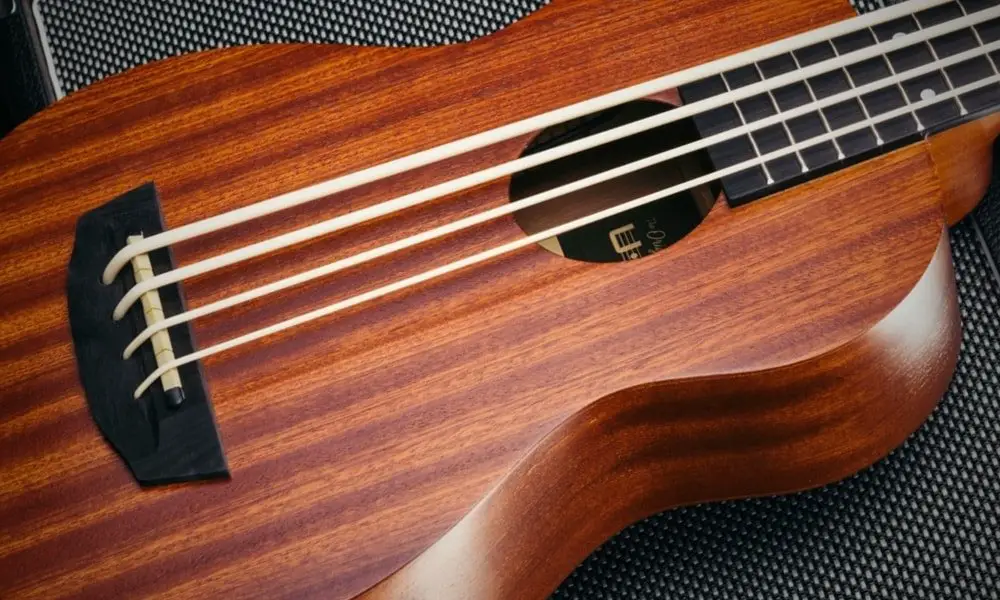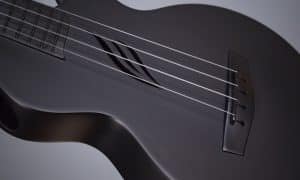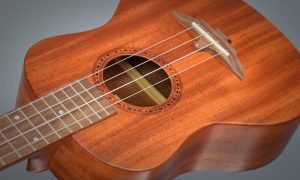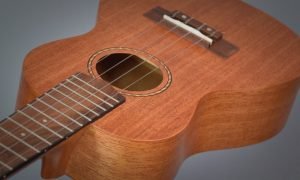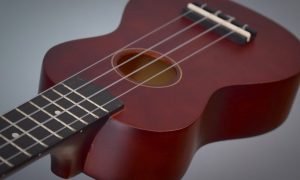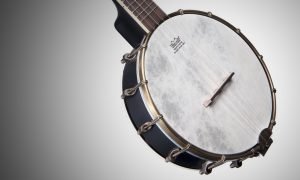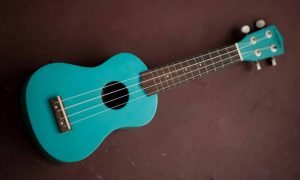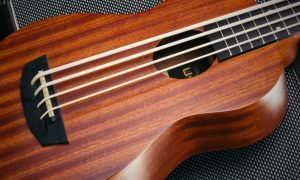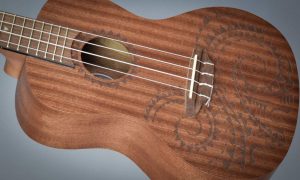The bass ukulele is unique hybrid instrument that has been growing in popularity over the last decade. These ukulele-sized basses produce a surprisingly big tone, making them a fun alternative to bass guitars and upright basses.
In part one of this article, I’ll review the best bass ukes I could find for sale online.
Part two of this article is a buyer’s guide that answers common questions people have about bass ukes.
Overview of Bass Ukes Reviewed in This Article
Here’s a quick rundown of all the bass ukuleles I cover in this article. Keep in mind that I’m not necessarily endorsing each of these models, so I suggest you read the individual reviews for my opinion of each uke.
Kala U-Bass Models
|
|
Kala Wanderer U-Bass | 107 Reviews | $269.00 | Check Current Price |
|
|
Kala Solid Mahogany U-Bass | 11 Reviews | Check Current Price |
|
|
Kala Exotic Mahogany U-Bass | 92 Reviews | $449.00 | Check Current Price |
|
|
Kala Rumbler U-Bass | 25 Reviews | $369.00 | Check Current Price |
Other Bass Ukulele Models
|
|
Donner DUB-1 Electric Ukulele Bass | 204 Reviews | $159.99 | Check Current Price |
|
|
Kmise Electric Ukulele Bass | 18 Reviews | $129.99 | Check Current Price |
|
|
Hadean UKB-23 Bass Ukulele | 78 Reviews | Check Current Price |
|
|
Oscar Schmidt OUB200K Uke Bass | 32 Reviews | $296.60 | Check Current Price |
What to Know Before Buying
I cover these points in more detail in the buyer’s guide below, but here are a few things should know before buying a bass uke.
The bass uke will feel very different
Whether you’re a bass player or a uke player, a bass uke will be unlike anything you’ve ever played. The fat, rubbery strings are kind of weird at first, so prepare to spend some time working on your technique if you want a good tone.
You’ll probably want an amp
You can certainly play a ukulele bass acoustically (without an amp) acoustically, but it’s hardly going to make any sound. If you really want to hear your bass uke, you’ll need to invest in an amp–preferably a bass amp.
It will take a long, long time to get your bass uke in tune
This is normal due to the stretchiness of the strings. It’s not a problem with the instrument or tuners. You’ll need to tune your bass uke a lot, especially when you first get it.
Kala U-Bass: The Original Bass Ukulele
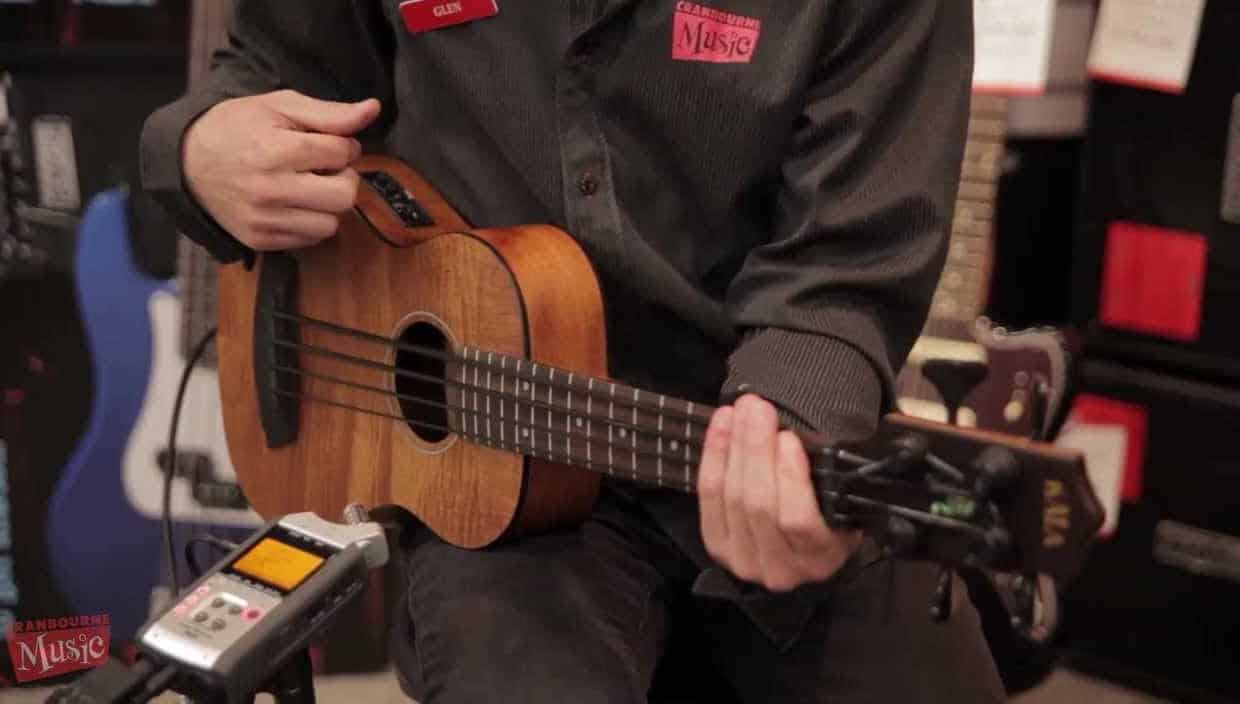
As far as I know, Kala’s U-Bass was the first mass-produced bass ukulele offered at a price the average person could afford.
Since Kala is the biggest name in bass ukes, I’m going to be spending a lot of time covering this brand and their various U-Bass models.
About Kala’s U-Bass
Based on a baritone ukulele body, the U-Bass is tuned exactly like a bass guitar. The shortened scale combined with fat, rubbery strings result in a tone that is surprisingly similar to the warm, mellow voice of a large, upright bass.
The U-Bass lineup has grown a lot since Kala introduced it in 2008. This model is now offered in a variety of materials, finishes, and price ranges. I’m going to cover some of their more popular models below.
1. Kala Wanderer U-Bass
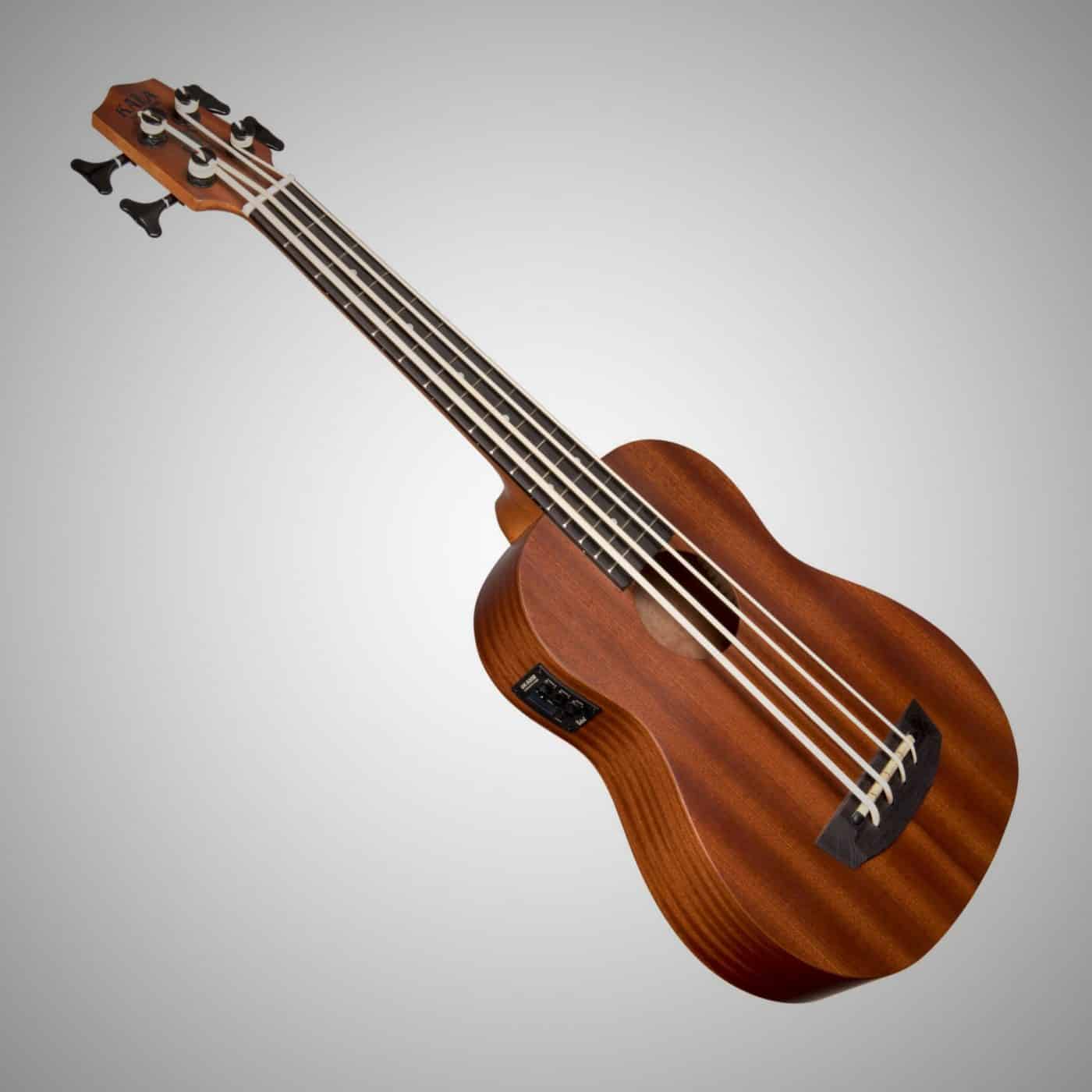
| 107 Reviews | $269.00 | Check Current Price |
The Wanderer is Kala’s simplest and most affordable U-Bass model. It has a laminated mahogany body and minimal cosmetic features, help keep the price down.
In terms of build quality, the UBASS-WNDR-FS is just as good as Kala’s fancier, more expensive U-Bass models. It’s a good option for players who want a good quality ukulele bass but don’t want to spend too much money.
Laminated Wood Body
The Wanderer has a laminated body, which is one way Kala can offer this uke bass at such a low price.
The all-laminated body probably won’t sound quite as warm and rich as the models I cover below that have solid wood.
However, I’ve played a ton of great-sounding laminated instruments over the years, so don’t let this single factor scare you away.
The Wanderer’s Other Budget-Friendly Features
Here are some of the other cost-saving features on a Wanderer:
- The nut and saddle are plastic rather than bone or a synthetic material like TUSQ
- It has generic tuners, versus brand-name Hipshot Ultralite on more expensive models
- The UK-500B pickup is a simple off-the-shelf electronics system, versus the proprietary Shadow NFX pickup found in higher-end models
- The included gig bag isn’t as heavy-duty as the bag that comes with more expensive models
2. Kala Solid Mahogany U-Bass
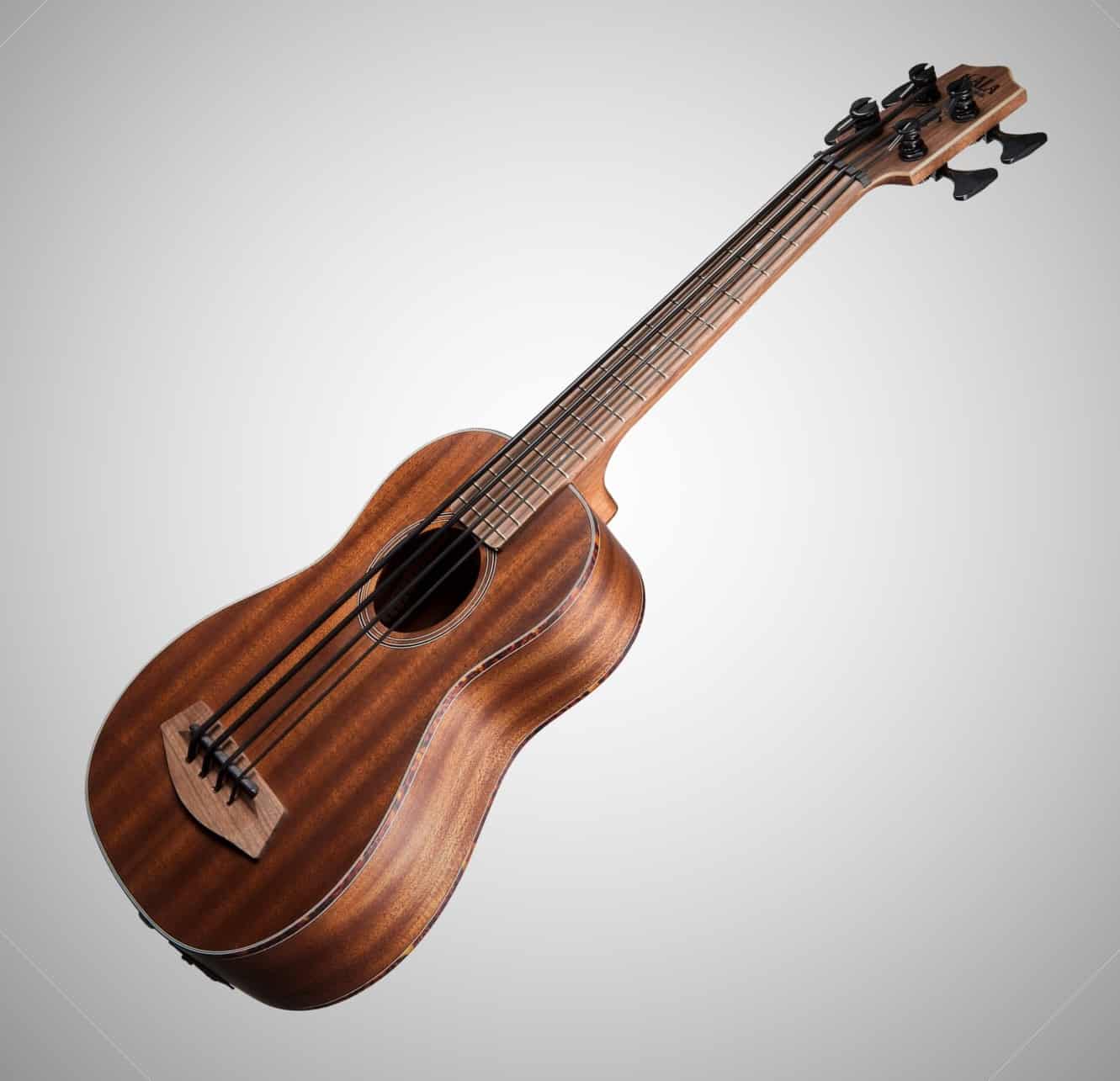
| 11 Reviews | Check Current Price |
This model is currently the only all-solid wood bass ukulele in Kala’s lineup, and it also happens to be the most expensive.
Features
The UBASS-SMHG-FS has a number of upgrades over the entry-level Wanderer and Rumbler series. These include:
- All-solid mahogany body
- TUSQ nut and composite saddle (better than plastic)
- Hipshot Ultralight tuners
- Custom Shadow NFX U-Bass pickup w/ built-in tuner
- Tortoise body binding
- Beveled headstock edge
- Inlaid headstock with Kala logo and frog
- Deluxe Kala gig bag
If you want Kala’s top-of-the-line ukulele bass and budget isn’t a concern, this model is worth a look. If you’re on a budget or just want to experiment with the bass uke, the other, more affordable models featured in this article are great choices as well.
Why Solid Wood?
As a general rule, solid wood produces a tone that is warmer, richer, and sweeter than laminated wood. However, I’ve found that this “fact” isn’t always true, especially in the realm of entry-level instruments.
I’ve played laminated ukuleles that sounded better than solid wood ukes from the same brand. Sure, solid wood usually sounds better, but you don’t have to buy a solid wood instrument to get good tone.
3. Kala Exotic Mahogany U-Bass
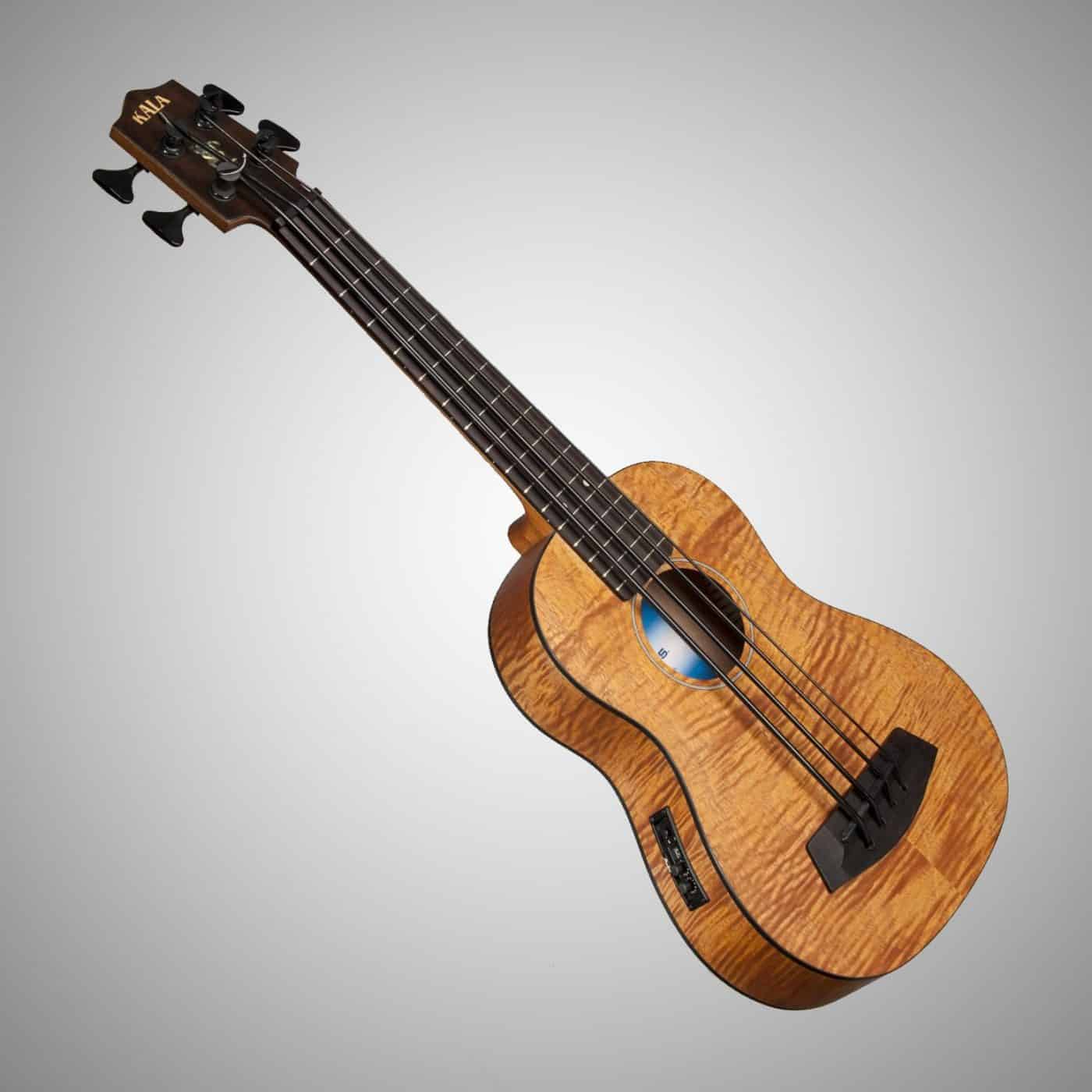
| 92 Reviews | $449.00 | Check Current Price |
The defining feature of this Kala ukulele bass is the “Exotic Mahogany” body. This wood is a type of figured mahogany with a gold stain that mimics the look of koa or flame maple.
According to Kala’s website, the Exotic Mahogany U-Bass is their best selling bass uke. I’ve seen these before in person and can see why. They’re beautiful instruments and the wood the use is usually really nice-looking.
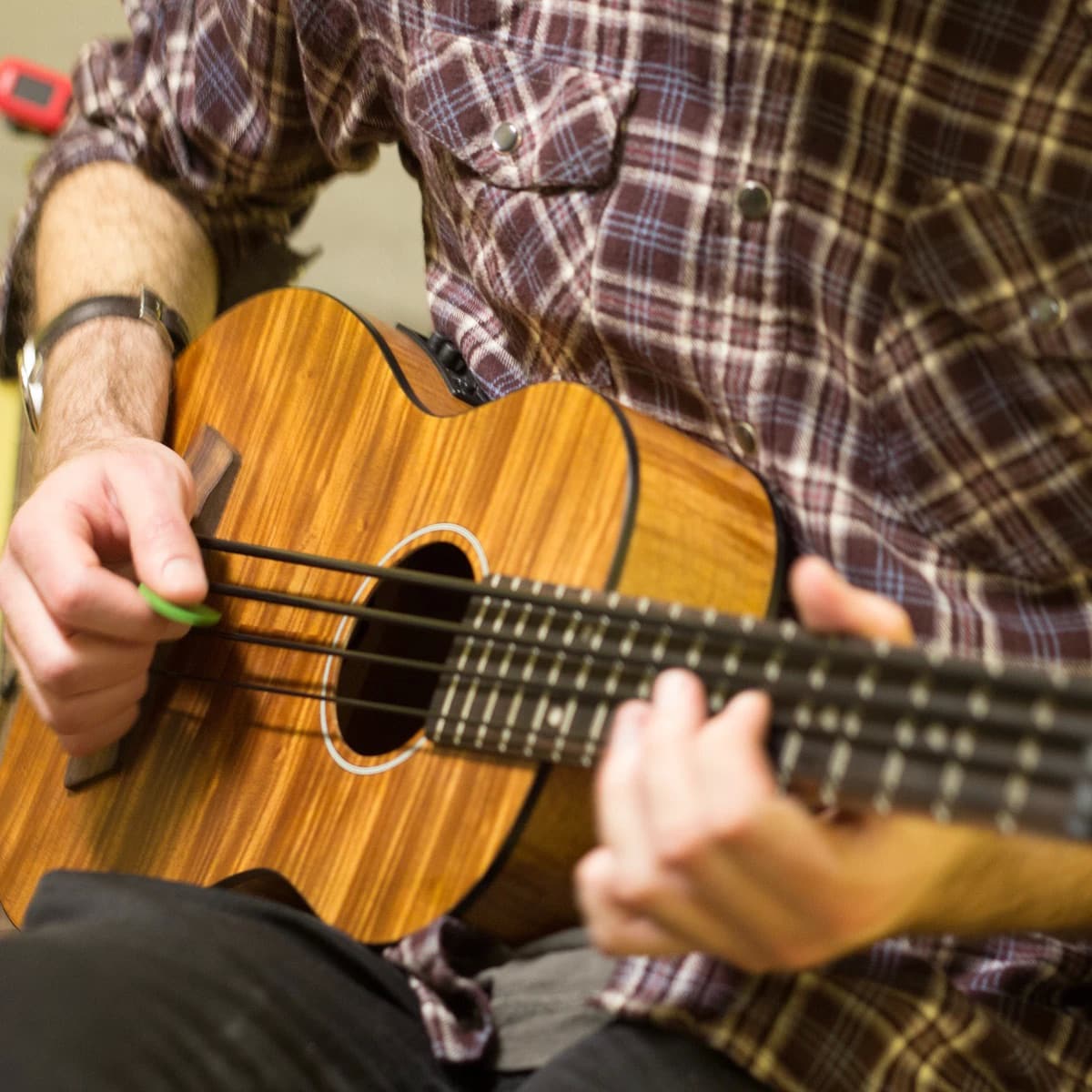
This U-Bass has most of the upgraded components found on Kala’s higher-end instruments. The laminated wood body helps keep the cost down, but it may not sound quite as warm as the models with solid wood.
4. Kala Rumbler U-Bass
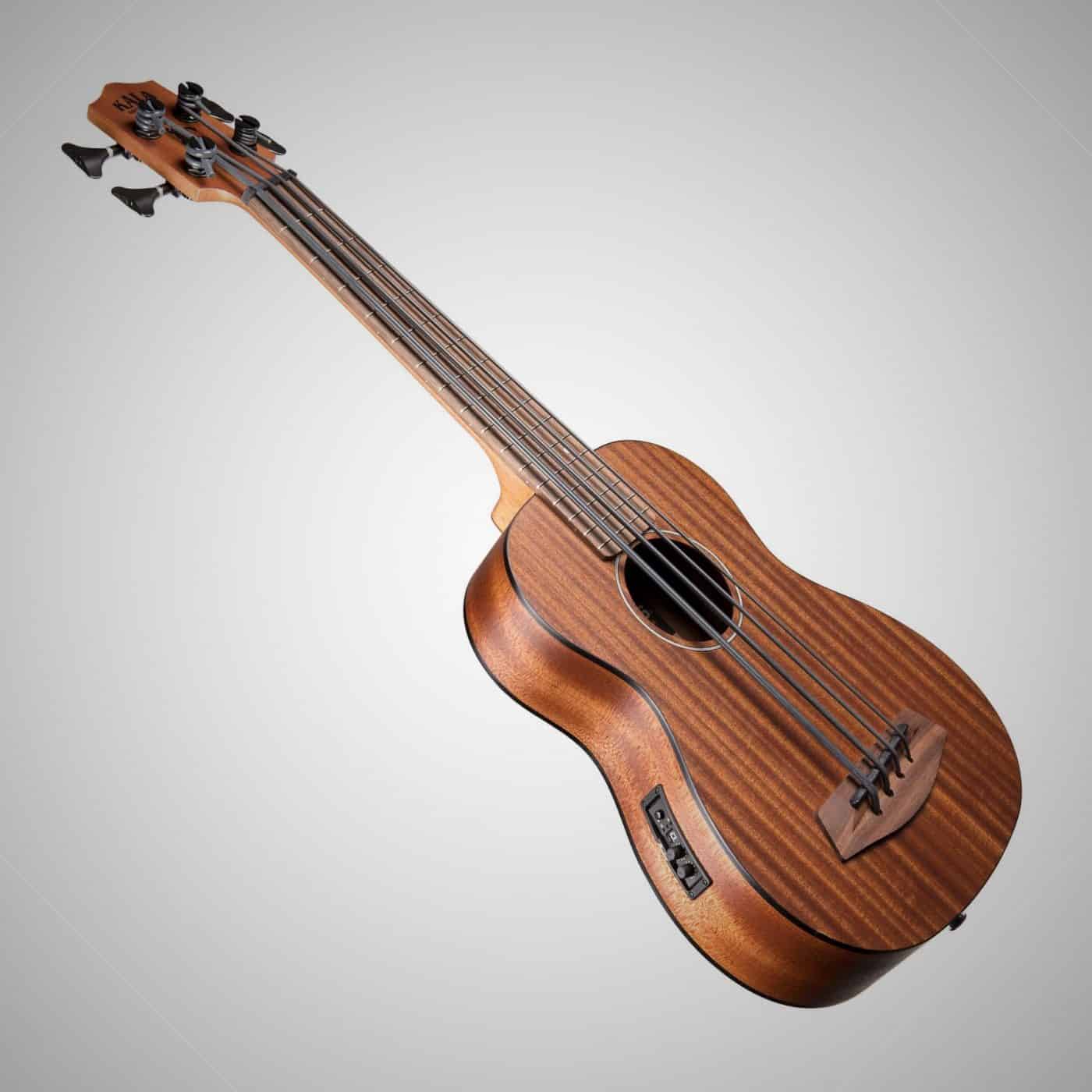
| 25 Reviews | $369.00 | Check Current Price |
The Rumbler is essentially an upgraded version of the Wanderer. It has the same laminated mahogany body as the Wanderer, but it has a few features usually only found on Kala’s higher-end models:
- TUSQ nut and composite saddle
- Custom Shadow NFX electronics with built-in tuner
- Bound body
- Deluxe gig bag
5. Kala Solid Spruce Top U-Bass
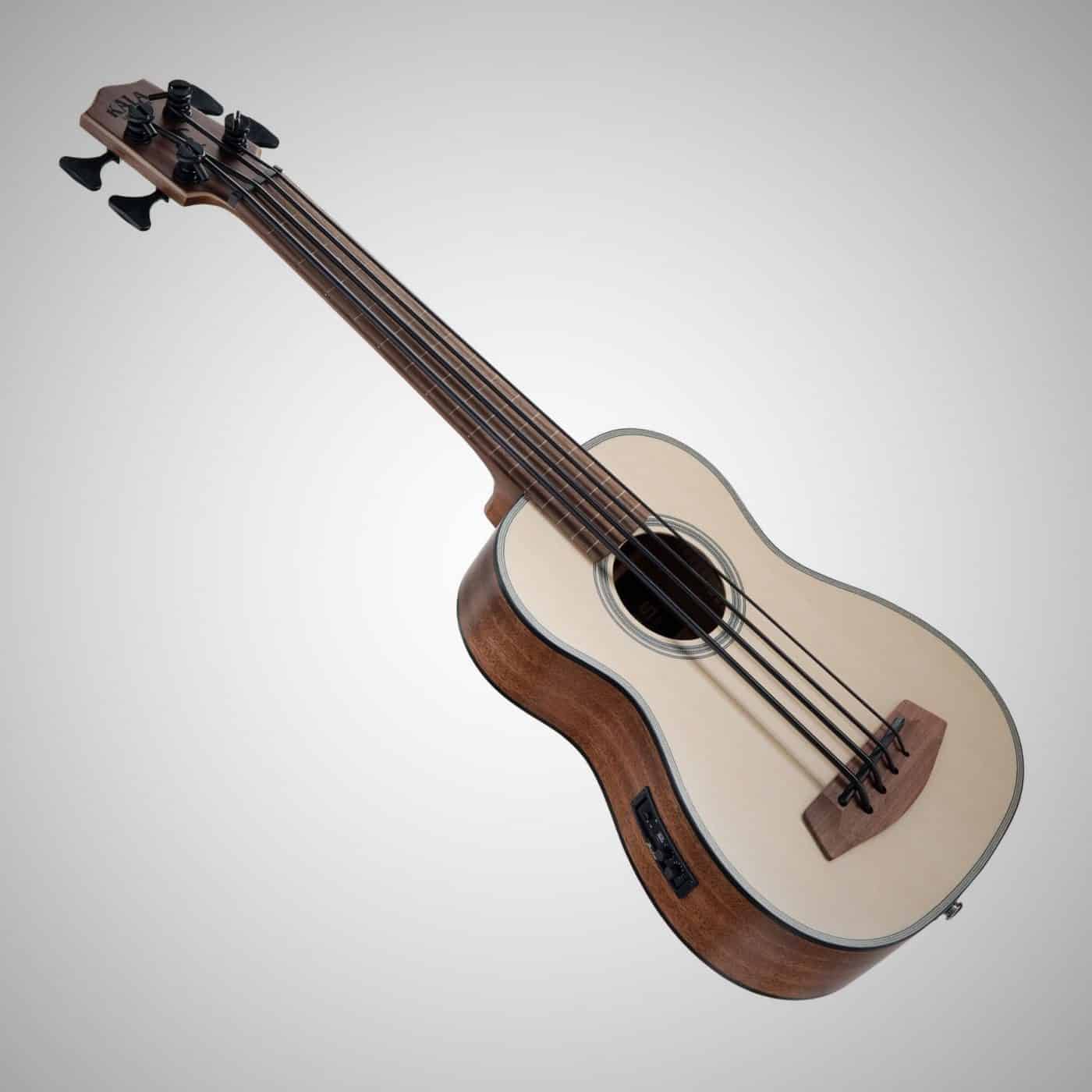
| 92 Reviews | Check Current Price |
The Solid Spruce Top U-Bass strikes a balance between the more affordable all-laminated models and the more expensive all-mahogany model.
By using a solid spruce top with laminate back and sides, this model combines the tonal benefits of solid wood with the affordability of laminated wood. This is a common building technique that many acoustic instrument manufacturers use.
Fretless Kala U-Bass
Most of Kala’s U-Bass models are available in a fretless version.
A fretless bass uke has a smooth fretboard with flush marker lines where the frets would normally be. A fretless fingerboard results in a smooth, mellow tone that’s a little closer to the sound of an upright bass. It also allows for neat sliding effects.
The drawback is that playing a fretless bass requires much more precision than a fretted bass. On a fretted instrument, the frets ensure your notes are always in tune. On a fretless bass, your finger placement needs to be perfect or the note you’re trying to play will be sharp or flat.
Experienced bass players looking for a specific sound may want to consider a fretless U-Bass, but for most people the standard fretted U-Bass is probably the safest choice.
Other Bass Ukuleles
Of course, Kala isn’t the only game in town when it comes to bass ukuleles. Seeing the popularity of the U-Bass, many other manufacturers jumped on the bandwagon and started offering their own version of the U-Bass.
A Quick Disclosure
I haven’t played any of these models, and I’m always reluctant to recommend any instrument I haven’t tried myself.
However, I own a Donner and a Kmise ukulele (Kmise review coming soon) and have played a number of Oscar Schmidt instruments over the years. With this in mind, I feel somewhat qualified to comment on these brands in a general sense, but please do your own research as well!
1. Donner DUB-1 Electric Ukulele Bass
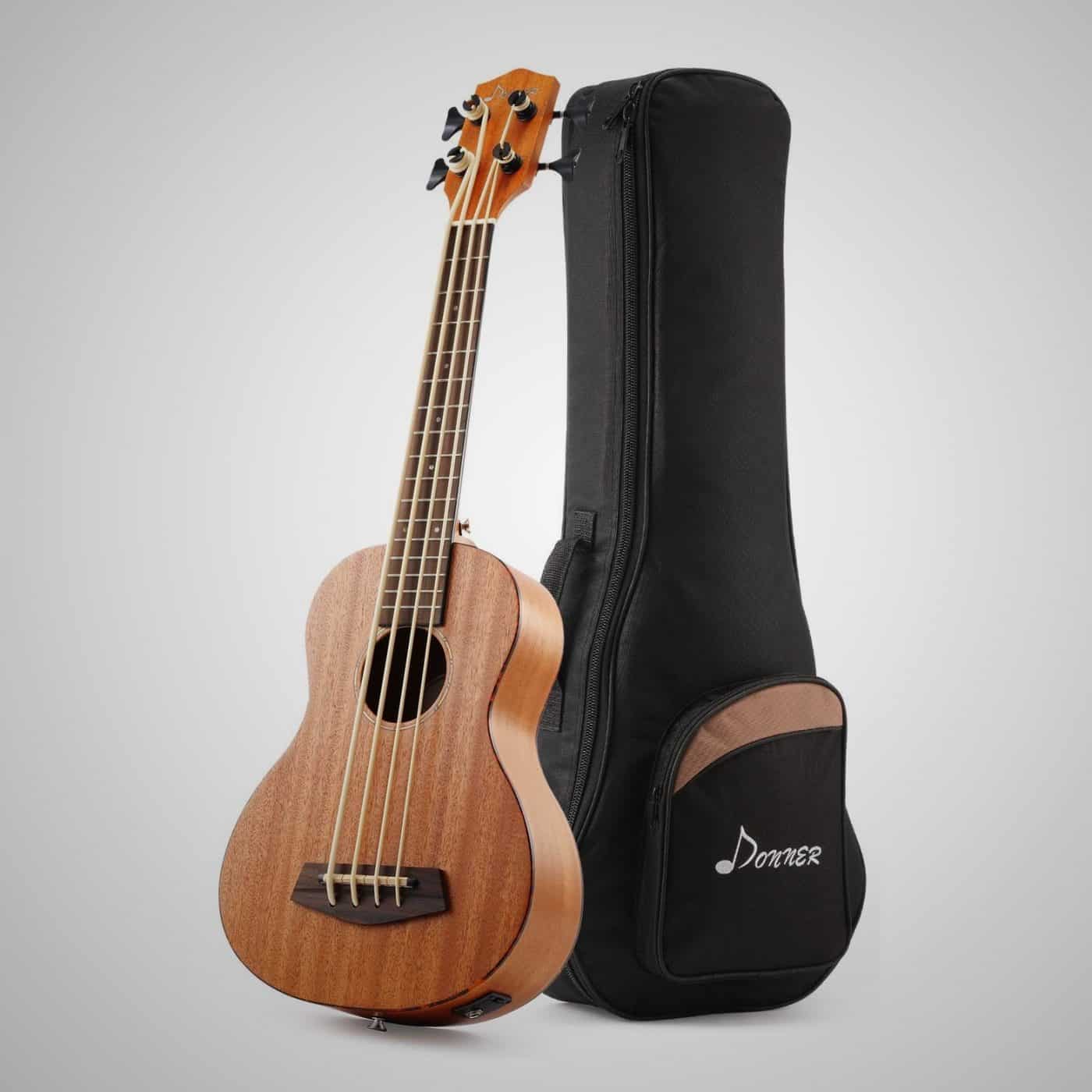
| 204 Reviews | $159.99 | Check Current Price |
I was very impressed with the Donner DUC-1 concert ukulele I reviewed. I felt it was a good ukulele for the money, especially when compared with models that cost nearly twice as much.
The Donner DUB-1 is considerably cheaper than the Kala U-Bass but still seems to be a good quality instrument. This might be the best option for people who want to play around with a ukulele bass but don’t want to make a big investment.
The majority of customer reviews praised the instrument’s tone, playability, and overall quality.
There were a few valid complaints among the negative reviews, such as issues with the pickup and tuner not working. But I also saw a lot of people who just had unrealistic expectations, or didn’t understand the quirks of bass ukuleles in general.
2. Kmise Bass Ukulele
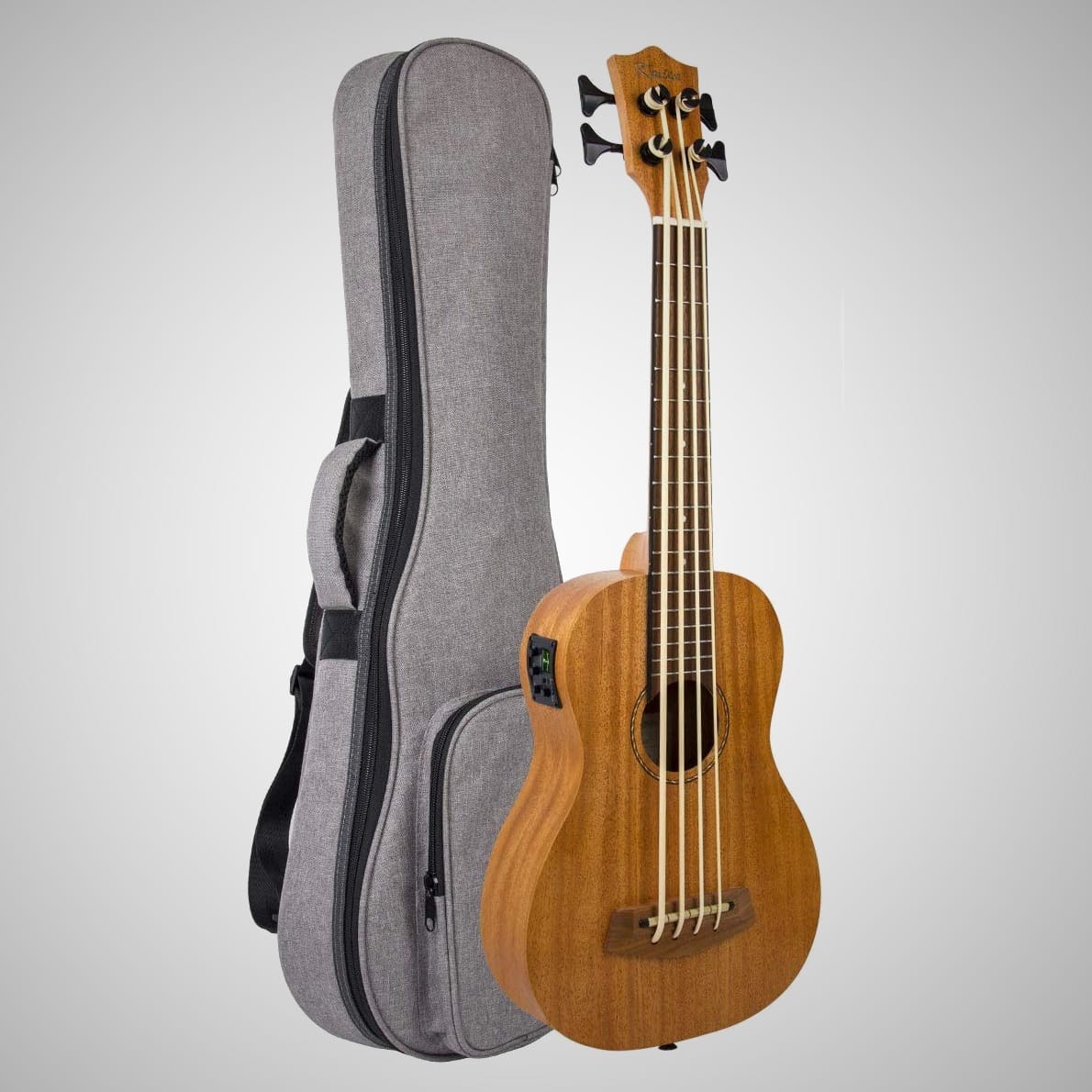
| 18 Reviews | $129.99 | Check Current Price |
I ordered a Kmise concert ukulele (review coming soon) and feel it’s a really nice instrument, especially at the budget-friendly price point. I don’t have any reason to believe the quality of their electric bass ukulele would be any different, but I haven’t played.
This model is currently the most affordable bass uke I’ve seen for sale online. Normally I’d be suspicious of a product that’s so much cheaper than the competition, but Kmise has a good reputation so I doubt you’d get burned with this uke.
If nothing else, Kmise offers a 30-day return policy, so if the uke doesn’t meet your expectations, you can always send it back.
A Quick Note About Customer Reviews
This model appears to have excellent customer reviews, but it’s important to know that most of those reviews are for Kmise’s regular ukes. By adding their bass uke to an existing listing that already has tons of good reviews, Kmise has “piggybacked” off the success of their older, more established.
There’s nothing inherently wrong with doing this, and I have no reason to believe that Kmise’s bass ukulele isn’t as good as their regular ukes. It’s just something I felt I should point out!
3. Hadean UKB-23 Bass Ukulele
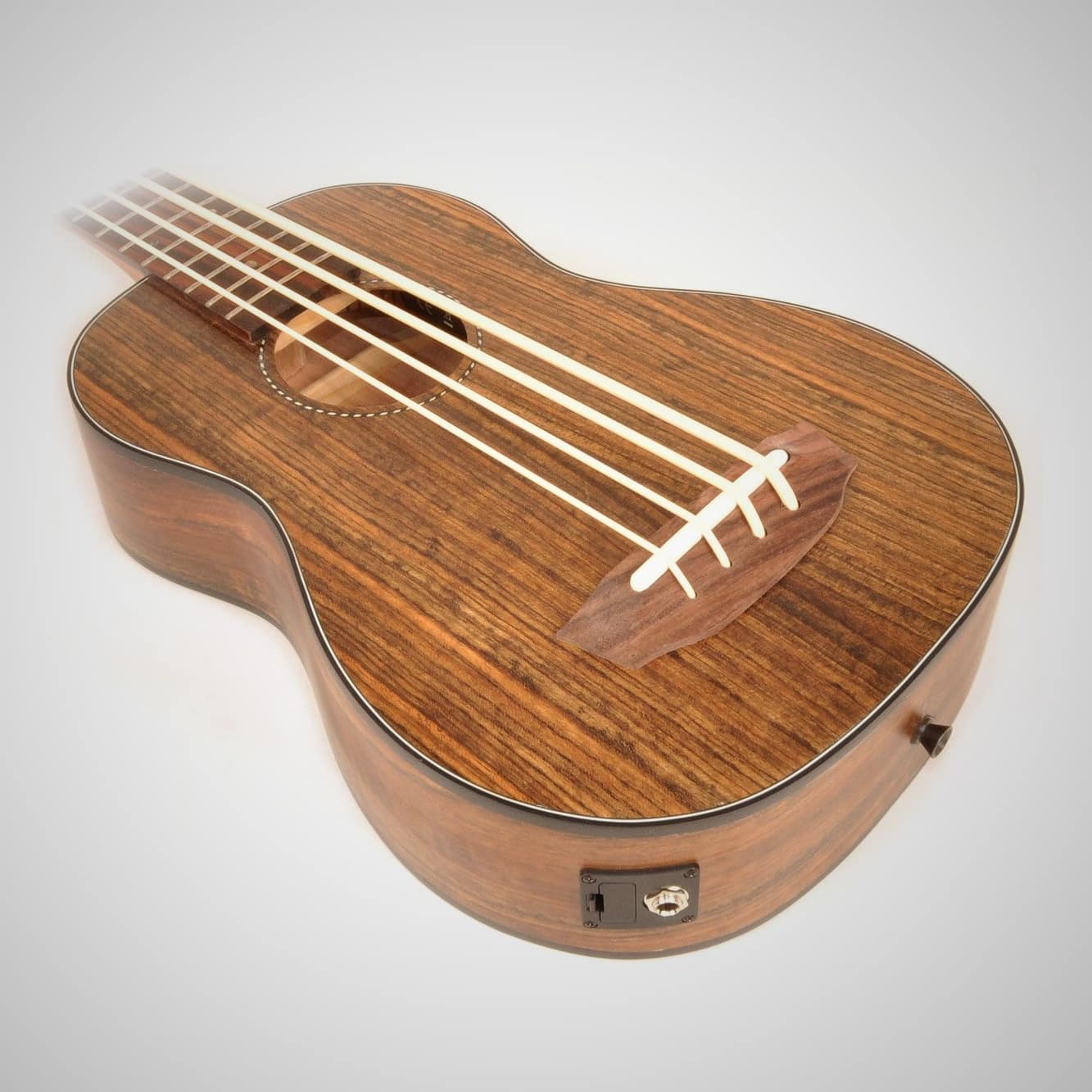
| 78 Reviews | Check Current Price |
I know very little about the Hadean brand, but this was one of the top-selling electric bass ukes on Amazon, so I wanted to include it.
The price on this one is hard to beat, and nothing jumped out to me as problematic. I liked the walnut body and rope rosette, which design features I’ve never seen before on an instrument in this price range.
Customer reviews were largely positive, with many praising the craftsmanship, tone, and value.
Most of the negative feedback appeared to be from well-intentioned people who didn’t quite know what they were signing up. As I’ve mentioned before, a bass uke is a very different animal from a standard ukulele. Be prepared to make some adjustments to you play style, technique, and tuning habits.
Since I have personal experience with Donner and Kmise I’d recommend those brands first, but the Hadean seems to be worth a look.
4. Oscar Schmidt OUB200K Uke Bass
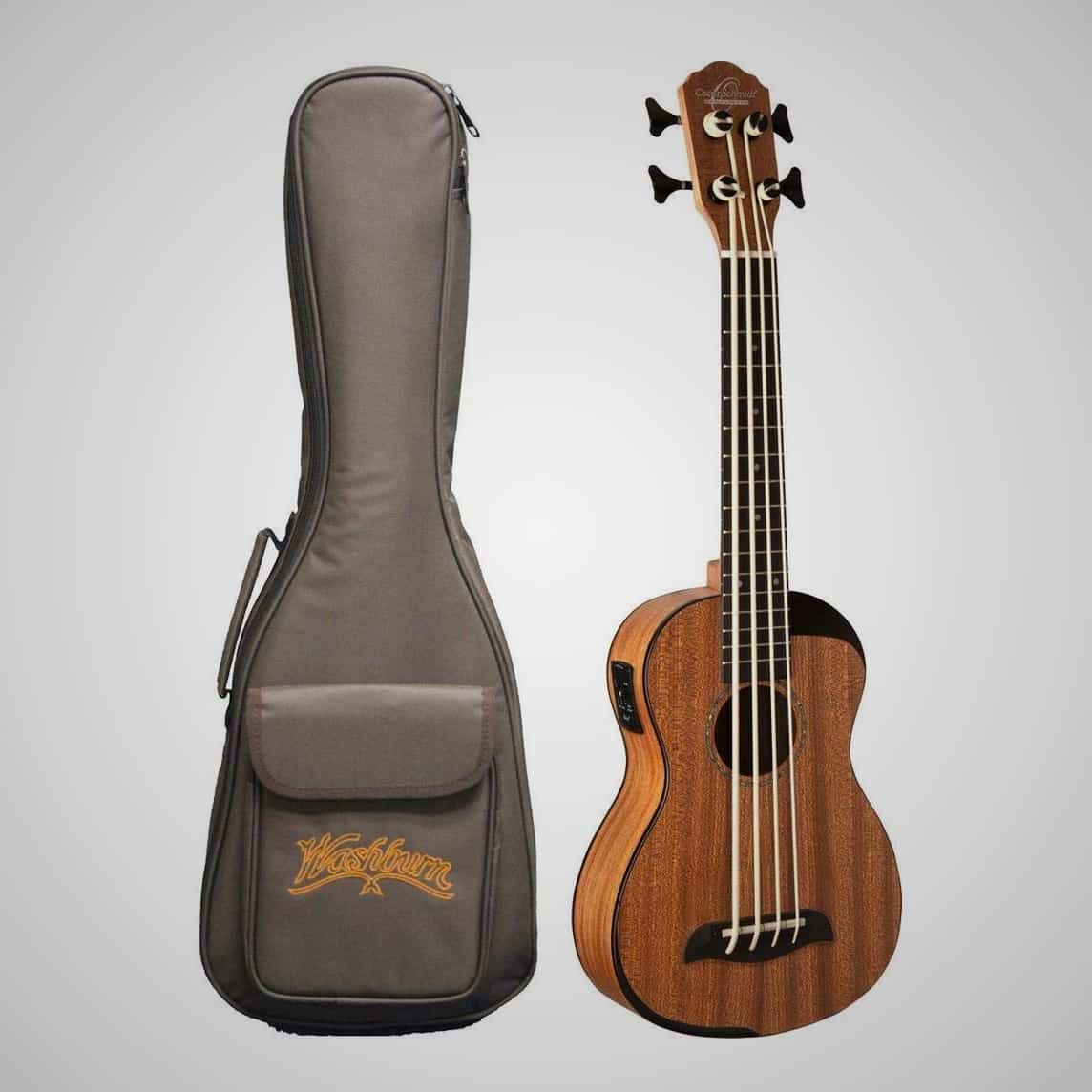
| 32 Reviews | $296.60 | Check Current Price |
As the manager of a small acoustic music store, I’ve come across a number of Oscar Schmidt instruments over the years, including guitars, mandolins, and standard ukuleles.
To be honest, I was never all that impressed with their instruments. They were usually OK, but never great.
Based on customer feedback, the OUB200K is decent, but probably not the best value. It does have some interesting design features, like the partial cutaway and beveled armrest.
I’m not sure how important these features are on a bass ukulele, but they certainly set it apart from the pack.
Bass Ukulele Buyer’s Guide
This section is designed to go over the basics of bass ukuleles and answer many common questions people have about the instrument.
What is a Bass Ukulele?
A bass ukulele is a ukulele-sized stringed instrument that’s tuned like a bass guitar or traditional upright bass.
The bass ukulele has existed in some form for a while, but Kala popularized it in the late 2000s with their U-Bass.
Most bass ukuleles are built around a baritone ukulele body, which is the largest of the four common ukulele sizes.
A bass ukulele has very thick, rubbery strings. Playing it feels different than any other stringed instrument I’ve tried.
Do You Need an Amp?

Bass ukulele are naturally very quiet instruments. All the bass ukes I’ve tried have had minimal volume and projection when played acoustically (with no amp).
I highly recommend using an amp with a bass ukulele, but it’s not a requirement. Just make sure you have realistic expectations before you buy something.
Should you buy a bass uke if you don’t have an amp?
Even if you don’t have an amp, a bass uke could still be fun for practicing at home or playing with one other person in a quiet environment.
If you want to play with a larger group or perform at any kind of venue, you’ll definitely need an amp.
Why are bass ukes so quiet?
A bass uke’s strings are fat, flexible, and have very low tension. Unlike the tight metal strings on a steel guitar, a bass uke’s strings don’t do a very good job of “driving” the instrument and causing it to vibrate. This is simply the trade-off that is required to get such low notes out of a small instrument with a short scale.
What Kind of Amp Should You Use With a Bass Ukulele?
A bass amplifier will sound best, but if you have a guitar amp laying around it should work too.
Guitar amps aren’t designed for the ultra-low frequencies of a bass instrument, so the output may not be as clean or clear sounding. Also, I’ve read it can be harmful to play bass through a guitar amp at very high volumes, but I haven’t verified that.
If you’re just starting out with the bass uke but already have a guitar amp, my suggestion would be to use the guitar amp for a while before investing in more gear. Of course, if you plan to start gigging with your bass uke right away, you may want a dedicated bass amp.
Bass Ukulele Size
Most bass ukuleles have a baritone ukulele body. This is the largest of the four standard ukulele body sizes, which makes it ideal for the low notes of a bass instrument.
The majority of bass ukuleles I’ve seen have are about 30″ long from end-to-end.
Bass ukuleles have a scale length of around 20″. This is slightly shorter than the 19″ scale length found on a baritone ukulele.
Bass Ukulele Tuning
Most bass ukuleles are tuned exactly like a standard bass guitar: E-A-D-G.
These are also the first four notes of a standard guitar, except one octave lower.
Bass Ukulele Tuning Vs. Baritone and Standard Ukulele
A baritone ukulele is tuned D-G-B-E. This is exactly like the four highest strings of a guitar.
A standard-tuned ukulele (soprano, concert, or tenor) is tuned G-C-E-A. This is like the four highest strings of a guitar at the fifth fret.
Bass Ukulele Strings
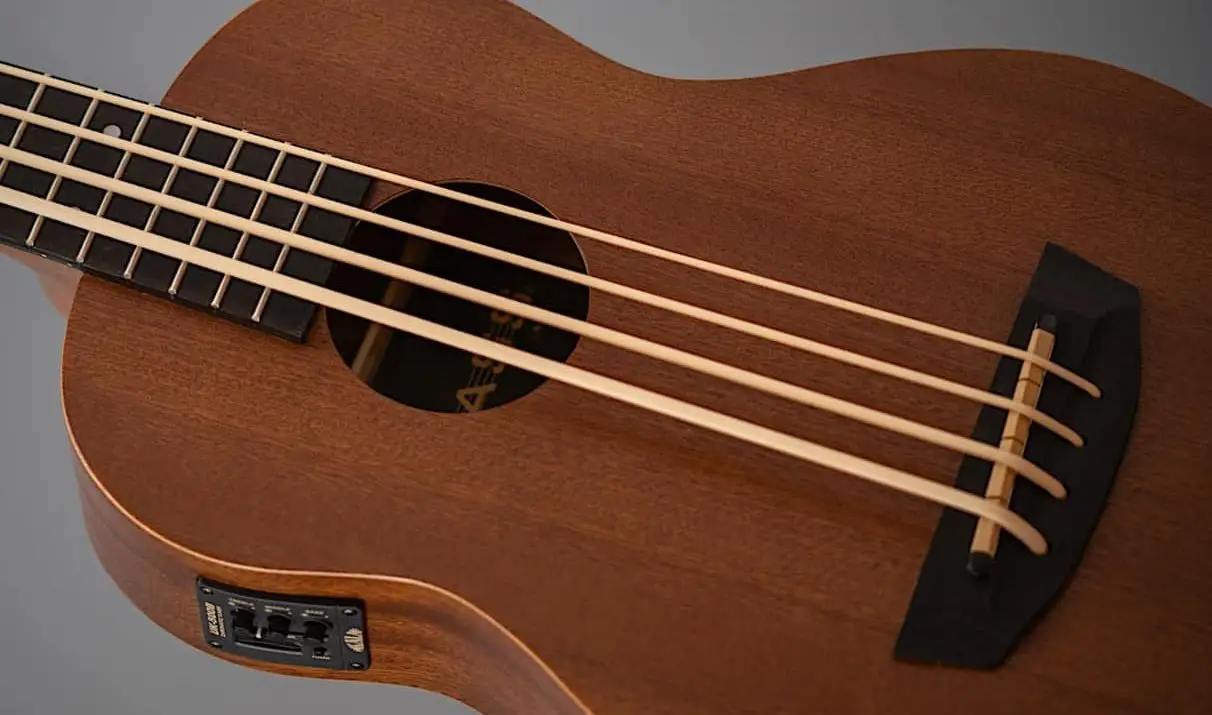
Bass ukes need to have very fat, rubbery strings to hit such low notes on their short 20″ scale. These strings are usually made of polyurethane or a similarly stretchy material.
Have you noticed how the lowest-pitched strings on a regular uke are also the thickest? A bass ukulele takes this concept to an extreme level.
Problems Tuning a Bass Ukulele
I mentioned this before but it bears repeating: Bass ukuleles can take a long time to get in tune, and they will go out of tune frequently. This is especially true for brand new strings.
I came across a few complaints about tuning difficulties. After reading the reviews, it was clear these folks just weren’t aware of how much stretching new bass uke strings will do.
This tuning quirk is due to the unusual nature of bass uke strings. Compared to metal-strung instruments like a guitar, bass ukulele strings are much more flexible and stretchy. Imagine a rubber band compared to a paper clip and you’ll see what I mean.
Types of Bass Ukulele Strings
With the rise in popularity of the bass uke, there is now a wider range of string choices available. The different materials will each have a unique tension, play feel, and tone.
For example, Kala makes a set of metal round wound strings that feel a little more like traditional bass guitar strings. Many users report that they are louder acoustically and produce a bright, punchy tone.
It’s not a bad idea to experiment with different strings, but it can get expensive since most bass uke strings cost over $25.
Strings are a big topic and deserve their own article. If you want to learn more, I’d start with this series of uke bass string tests.
How to Play a Bass Ukulele
The bass ukulele is closer to a bass than a ukulele. If you already know how to play bass, the bass uke will be a natural second instrument for you. However, the playing technique is a lot different due to the bass uke’s short scale, low tension, and unique strings.
The Fat Strings Require a Different Technique
As I’ve mentioned before, the thick, stretchy strings on a bass ukulele will feel very foreign at first and can take some time to get used to.
In addition to their unusually large diameter, bass uke strings feel kind of loose or “floppy” compared to other stringed instruments I’ve played. This can feel strange at first, since many bass and uke players expect more resistance from their strings.
The technique required to get good tone out of a bass uke is a bit different than a traditional bass or ukulele. For example, when playing a bass uke, you’ll need to pluck the strings closer to the bridge. If you play up by the neck joint like on a standard ukulele, you’ll be a lot more likely to get buzzing and slapping sounds.
Something else I’ve noticed: Since the strings are so loose and grippy, they can feel like they want to “roll” under your fingers when you pluck them. This is another reason why perfecting your technique and touch are crucial.
Most People Use Their Fingers
Most people play a bass ukulele using their fingers. Some players use picks made from felt, rubber, or leather, but this isn’t as common.
Bass Ukulele Vs. Baritone Ukulele Vs. Standard Ukulele
Most bass ukes have the same body size as a baritone ukulele. Standard ukuleles are all smaller than a bass uke.
Different Tunings
- Bass ukulele: E-A-D-B
- Baritone ukulele: D-G-B-E
- Standard ukulele: G-C-E-A
Most ukuleles are tuned the way you see below. There are alternate tunings, but these aren’t very common.
Different Scale Lengths
- Bass ukulele: 20″
- Baritone ukulele: 19″
- Soprano, concert, and tenor ukulele: Between 13.5″ and 17″
These scale length figures apply to most ukulele, but they aren’t universal.
Strings
Bass ukes use thick, rubbery strings to reach the lower registers of a bass instrument. These strings will feel very unusual to most first-time bass ukulele players and can take some getting used to.
Baritone, tenor, concert, and soprano ukes all use thinner strings that are gauged specifically for their size.
Play Style
A bass ukulele is played like a bass guitar. The index and middle fingers are used to pluck out bass lines, and they aren’t usually strummed.
Baritone and standard-tuned ukuleles can be strummed or fingerpicked. The play style of these instruments is much closer to a guitar.
You Might Also Like...
-
Best Electric Ukulele Reviews: 2022 Edition
Looking for a good uke you can plug into an amp? See my picks for the best acoustic-electric ukes at the beginner price range.
-
How to Buy A Ukulele: The 2024 Ukulele Buying Guide
You've decided to buy a ukulele, now what? My ukulele buying guide will help you choose a ukulele that meets your needs and budget.
-
The Best Cheap Ukuleles (2022 Edition)
Buying a cheap ukulele is tempting, but it's easy to get burned. My guide to the best cheap ukes has everything you need to know to find a great budget uke.
-
Ukulele Sizes: The Complete Guide to Different Uke Sizes
Confused about uke sizes? This guide explains the different ukulele sizes (soprano, concert, tenor, baritone) and discusses which sizes are best for beginners.
-
Ukulele Vs. Guitar: What's The Difference?
The ukulele and guitar have a number of big differences, but they have more in common than you might think. Take a closer look at the ukulele vs. guitar.

